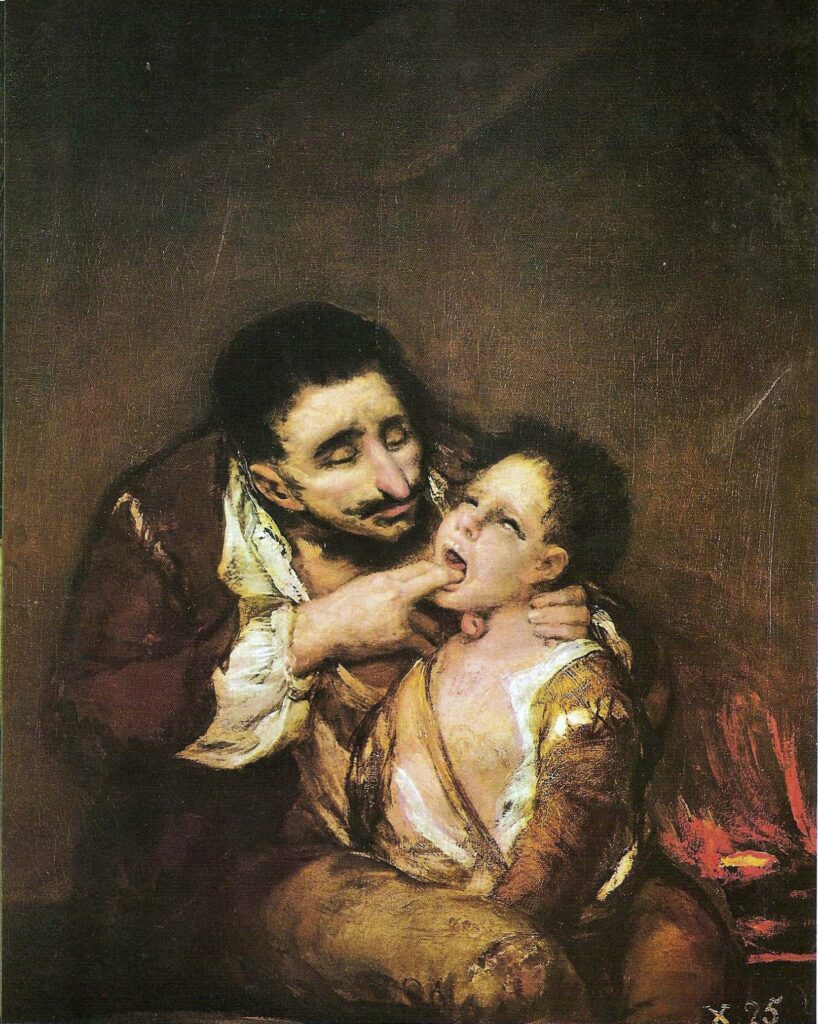Vicent Rodilla
Valencia, Spain

Diphtheria is a bacterial infectious disease caused by Corynebacterium diphtheriae that affects mostly children. Although by 2017 some 85% of infants worldwide have been vaccinated for DTP (diphtheria-tetanus-pertussis), some 19.9 million children remain unvaccinated.1 According to the World Health Organization, reported cases of diphtheria have decreased from nearly 100,000 in 1980 to 16,435 in 2017. In the developed world diphtheria has now become rare because of the effectiveness of the toxoid vaccine and widespread vaccination, but there were still more than 7,000 cases in each Southeast Asia and Africa in 2017.2
The term diphtheria was coined by Pierre Fidèle Bretonneau, who carried out autopsies on affected patients. He presented his findings to the French Academy of Medicine in 1821 and published Les inflammations du tissu muqueux et en particulier de la diphtérite in 1826. Diphtheria (from the Greek diphthera “leather”) was the word chosen to describe the appearance of a pseudomembrane in the throat.
Diphtheria epidemics have occurred throughout history. Harmann Schedel wrote the first valid description in the Nuremberg Chronicle, summarizing the characteristics of the epidemic of 1492.3 Luis Mercado, a medical professor in Valladolid, Spain, was probably the first to consider diphtheria infectious in his 1613 Consultaciones morborum complicatorum et gravisimorum.4,5 Juan de Soto, a professor of medicine in Granada, Spain, also wrote a treatise on diphtheria, referring to the terrible 1613 epidemic in Spain as “el año del [the year of] garrotillo.”6 In Spanish diphtheria was commonly referred to as garrotillo, a diminutive from garrote, an execution device used to strangle the victim with a rope or metal wire.
The symptoms of diphtheria range from mild to severe. Infection of the respiratory system damages healthy tissues, which, when dead, accumulate in the form of a “pseudomembrane.” This is a dense greyish material in the pharynx, which in serious cases may build up extensively. Diphtheria can also cause swelling of the glands in the neck and this is sometimes referred to as a bull neck. When untreated, diphtheria leads to death from obstruction of the upper respiratory airways by this pseudomembrane, hence the name of garrotillo (little strangulation) in Spanish.
One of Francisco de Goya’s paintings, Lazarillo de Tormes (Fig. 1), is now considered (since the analysis of the inventory of Goya’s properties carried out in the second half of the twentieth century7,8) to represent an episode of the picaresque novel The life of Lazarillo de Tormes and of his fortunes and adversities. The painting seems to represent an episode in which the blind man opens the mouth of the young Lazarillo to smell and detect if he has eaten a stolen sausage. Before this, however, the painting was named and is still popularly known as El garrotillo (Fig. 1). The painting shows a dark interior, illuminated by fire, and an older man restraining a young boy. The man holds the boy’s neck with one hand and inspects his mouth with his other. Gregorio Marañón (1887-1960), a prestigious Spanish physician who was bequeathed this painting, envisioned some of the popular practices that may have been used at the time to alleviate or cure those affected by diphtheria, giving the painting its popular name. Perhaps the man is trying to remove the membrane or perhaps he is holding some instrument that may have been heated up in the fire to cauterize the tissue. It must have been terrible to see children being slowly asphyxiated, and many people likely tried to clear the airways by removing the pseudomembranes with their fingers or with an instrument, as the old man seems to be doing in Goya’s painting El garrotillo.
References
- VanderEnde K, Gacic-Dobo M, Diallo MS, Conklin LM, Wallace AS. Global Routine Vaccination Coverage — 2017. MMWR Morb Mortal Wkly Rep. 2018;67(45):1261-1264. doi:10.15585/mmwr.mm6745a2.
- WHO. Global Health Observatory (GHO) data. http://www.who.int/gho/immunization/en/. Accessed November 23, 2018.
- Snodgrass ME. World Epidemics : A Cultural Chronology of Disease from Prehistory to the Era of Zika. Second. North Carolina: McFarland & Company, Inc; 2017.
- Laval R E. El garrotillo (Difteria) en España (Siglos XVI y XVII). Rev Chil Infect. 2006;23:78-80.
- Amorós Sebastiá L, Ferrer Baixauli F, Salavert Fabiani V, López Martínez R. La difteria y los médicos españoles del renacimiento. Acta Otorrinolaringol Esp. 2002;53:146-150.
- Pelta R. El garrotillo: una contribución de médicos españoles al conocimiento de la difteria. http://elmedicointeractivo.com/el-garrotillo-una-contribucion-de-medicos-espanoles-al-conocimiento-de-la-difteria/. Accessed November 23, 2018.
- Salas Bosch X de. Sur les tableaux de Goya qui appartinrent à son fils. Gaz des B-art. 1964:99-110.
- Wilson-Bareau J. Goya and the X Numbers: The 1812 Inventory and Early Acquisitions of “Goya” Pictures. Metrop Museum J. 1996;31:159-174. doi:10.2307/1512979.
VICENT RODILLA, PhD, is a lecturer at the Faculty of Health Sciences, Universidad CEU Cardenal Herrera in Valencia, Spain. Amongst other subjects, he teaches the history of medicine and an introduction to epidemiology to medical students. He has an interest in the visual arts and their representation of medicine.
Highlighted in Frontispiece Volume 11, Issue 2– Spring 2019

Leave a Reply